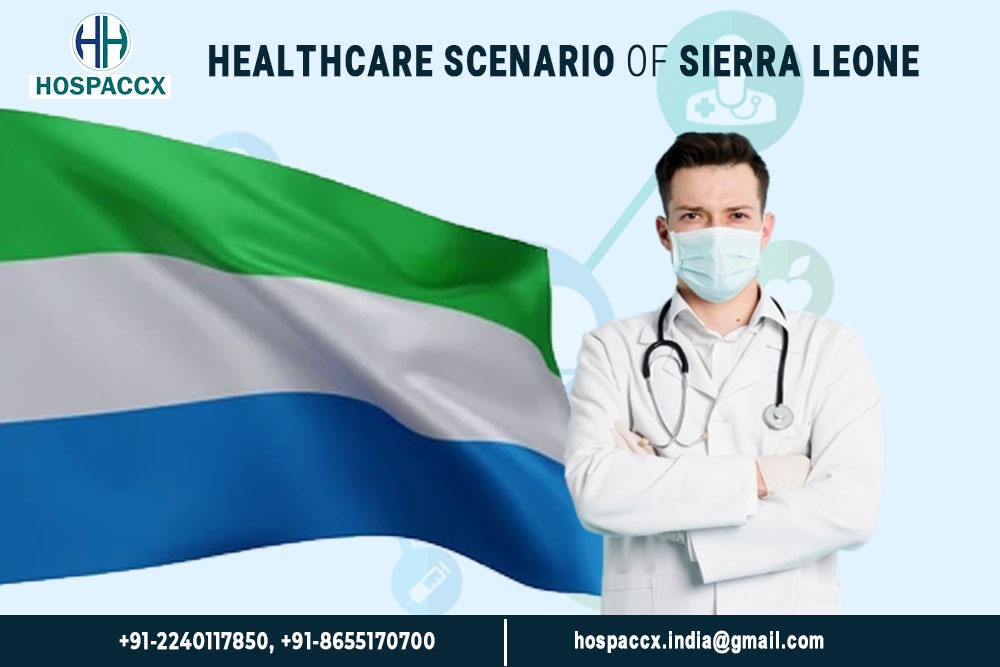HEALTHCARE SCENARIO OF SIERRA LEONE
Are you planning to build or restructure or venture in any healthcare venture in Sierra Leone? Looking for information about the major healthcare players in government, private diagnostic centers that are available in Sierra Leone? Are you looking to find out which part of the cities is best to venture in or what all facilities are available and what all should be planned for new setup? In this article Hospaccx Healthcare Consultancy has mapped all on major players in terms of medical facilities and healthcare scenario of Sierra Leone.
This is the superficial and macro level survey if you need a refined market and financial feasibility or any other study related to healthcare is required you can contact Hospaccx Healthcare business consulting Pvt. ltd on Hospaccx.India@gmail.com or you can visit our website on www.hhbc.in
INTRODUCTION
Sierra Leone is situated on the coast of West Africa with a population of 8.3 million as of July 2022, of which at least 43.3% population live in the urban areas of the capital Freetown. Its development has been hampered by a civil war between 1991 and 2002 and more recently by the Ebola outbreak of 2014, which claimed nearly 4000 lives, 90 of them were qualified health care workers (approximately 7% of the workforce).
In Sierra Leone, both the quality and accessibility of the healthcare system are rated very low. Infant and maternal mortality rates continue to be among the highest in the world. The major causes of illness within the country are preventable with modern technology and medical advances. Most deaths within the country are attributed to nutritional deficiencies, lack of access to clean water, pneumonia, diarrheal diseases, anemia, malaria, tuberculosis and HIV/AIDS.
STATISTICS OF SIERRA LEONE
| Total population (2022) | 8,307,892 |
| GDP per Capita | 650 USD |
| Life expectancy at birth m/f (2022) | 55.55 years |
| Probability of dying under five (per 1000 live births (2020) | 107 |
| Probability of dying between 15 and 60 years m/f (per 100 population , 2020) | 37.78 |
| Total expenditure on health per capita (US $, 2019) | $46 |
| Total expenditure on health as % of GDP (2019) | 8.7% |
HEALTH EXPENDITURE
In 2019, Total Health Expenditure in Sierra Leone amounted to $46 per person. Total Health Expenditure includes government, donor and private expenditure such as user fees. The Government’s contribution is very low, just $16 in 2012, 16.6% of overall health expenditure. This is supplemented by donor resources. Sierra Leone is working towards Universal Health Coverage and $1.1 billion has been pledged by donors just to tackle the impact of Ebola in Sierra Leone.
Private insurance plays a minimal role in Sierra Leone, whereas traditional healers and alternative medicine play a strong role, partly as a result of the high costs of healthcare. Spending on healthcare is split into two parts.
Drugs are sold on a cost recovery basis. Services provided and costs generated as part of the Free Healthcare Initiative are not funded by user fees. This includes the provision of free drugs for most common conditions, medical equipment, salary top up for health workers based on additional work done, as well as technical and logistical support.
SOCIO-ECONOMIC OVERVIEW
Economic growth in Sierra Leone is projected to 4.8% in 2022 from 4.1% in 2021 and it is driven by increased activities in agriculture and construction as well as the resumption of iron ore production and exports. Growth in these labor-intensive sectors could make a dent on poverty which remains widespread in the country (more than half of the population lives in poverty, according to the latest Sierra Leone Integrated Household Survey (SLIHS)). Agriculture will continue to drive the non-iron ore gross domestic product (GDP) growth, with the sector expected to grow by 4.2% in 2019, spurred by increased investments and expansion in the crops, livestock and fisheries sub-sectors. The growth in services is expected to slow due to weaker performance in tourism, transportation and communication.
Mining and the recovery of the agricultural, manufacturing, construction, and tourist sectors, are expected to enhance growth to 4% in 2022 and 4.2 % in 2023. The conflict between Russia and Ukraine led to an increase in inflation reaching 22.44% in April 2022. The fiscal deficit will continue to improve as the government strengthens its fiscal consolidation measures. As a result of increased tax revenue supported by better economic activity and rationalized expenditure, the fiscal deficit is anticipated to decline to 4.4 % of GDP in 2022 and 4 % in 2023.
Real GDP growth is anticipated to accelerate to 4.8 % in 2022 as the lifting of Covid-19 restrictions has led to improving labor market conditions and increasing household consumption. In Sierra Leone, the personal income tax rate is 15% and the corporate tax rate is 30 %, as of 2022.
Until the outbreak of Ebola in May 2014, Sierra Leone was seeking to attain middle-income status by 2035, but the country still carries its post-conflict attributes of high youth unemployment, corruption and weak governance. The country continues to face the daunting challenge of enhancing transparency in managing its natural resources and creating fiscal space for development. Problems of poor infrastructure and widespread rural and urban impoverishment persist despite remarkable strides and reforms.
HEALTH SYSTEM IN SIERRA LEONE
The Sierra Leone health care system is organized into two tiers of care:
- Peripheral Healthcare Units (PHUs) with an extended community health programme
- Secondary care which includes 21 district and three referral hospitals; there are also 45 private clinics and 27 private hospitals.
The PHUs are further subdivided into:
- Maternal and child health posts serving a population of 500–5,000
- Community Health Posts serving a population of 5,000–10,000 staffed by State-Enrolled Community Health Nurses (SECHNs)
- Community Health Centers (CHCs) serving a population of 10 000–30000.
Community Health Centers are run by Community Health Officers (CHOs) supported by SECHNs, lab assistants and environmental health workers. In total, there are approximately 1185 PHUs, of which 231 are CHCs.
CHALLENGES IN HEALTHCARE
The Sierra Leonean health system faces challenges due to chronic underfunding, a heavy disease burden and vastly insufficient numbers and skewed distribution of skilled Human Resources for Health (HRH). Capacity, both in terms of numbers, skills and distribution of HRH, is one of the main barriers to improving the health care. This is being addressed through the implementation of HRH strategic plan 2017-2021. An important barrier to accessing health services is the cost of services and the inability of the population to financially access service. To address financial inaccessibility, the Free Healthcare Initiative was introduced in 2010 to abolish user fees for all
pregnant and lactating women and under-five children.
HEALTHCARE INSURANCE
Government launched the Sierra Leone Social Health Insurance (SLeSHI) in 2018 to improve financial accessibility to health care. To address financing for health holistically, the Government has initiated the process to develop a comprehensive health financing strategy. Achieving adequate quality of care is a recurrent challenge in Sierra Leone. With stock-outs and shortages, drug availability in health systems remains a challenge. The legal and policy framework for the pharmaceutical sector has been put in place and disseminated but is not well-enforced.
Free health care was introduced in 2010 for children under 5, pregnant or lactating women and following the devastating effects of the 2014 outbreak for Ebola survivors as well. The remaining population covers their own costs; the majority of patients utilize traditional “country” remedies as a first line of treatment and present to the government health service late; also, wealthy individuals employ private health care, either domestically or overseas.
BURDEN OF DISEASES
Sierra Leone is one of the most severely Malaria-burdened Nations in Africa, with its entire Population of over 7 million people at risk of the disease. It has a generalized HIV/ AIDS Epidemic with a National Prevalence of 1.5%; in 2017 there were an estimated 2812 new HIV infections and 2390 AIDS-related Deaths. Sierra Leone has one of the highest Tuberculosis (TB) burdens per capita in the world, with an estimated 22 000 cases per year.
Ischemic Heart Diseases still are high among the Population of Sierra Leone. During the year, Sierra Leone, a signatory to the Framework Convention for Tobacco Control (FCTC) treaty, attained significant milestones towards Tobacco Control.
Sierra Leone faces severe shortages of Mental Health Clinicians, drugs, and Infrastructure, despite an estimated Burden of 75 000 people with severe Mental Disorders and 350 000 people with Depression (based on Global Prevalence Rates)
MAJOR HOSPITALS
- Connaught Hospital
- Hatfield Archer Memorial Hospital
- Kerry Town Ebola clinic
- Koidu Hospital
- Ola During Children’s Hospital
- Princess Christian Maternity Hospital
- Masanga Hospital
- Sierra Leone Psychiatric Hospital
- St John of God Hospital
- Government Hospital Pujehun
MAJOR DIAGNOSTIC CENTERS
- EcoMed Medical Center
- ASPEN clinic
- AMI clinic
- Choithram Memorial Hospital
- Davidson Nicol Medical Center
CONCLUSION
We can conclude that there is a lack of human resources with a 1.4 doctors, nurses and midwives per 10,000 population compared to the threshold of 44.5 set in 2016. Sierra Leone also lacks healthcare infrastructure with about 80 hospitals for the whole country and diagnostic centers with advanced diagnostic facilities that allows a potential for market entrants.
It is the superficial and macro level study for more details kindly contact Hospaccx Healthcare business consulting Pvt. ltd on Hospaccx.India@gmail.com or you can visit our website www.hospaccxconsulting.com










